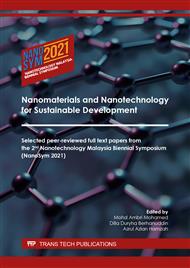[1]
F. Zulfiqar, M. Navarro, M. Ashraf, N.A. Akrame, S. Munné-Bosch, Nanofertilizer use for sustainable agriculture: Advantages and limitations, Plant Sci. 289 (2019).
DOI: 10.1016/j.plantsci.2019.110270
Google Scholar
[2]
M.N. Khan, M. Mobin, A. Zahid, S. Alamri, Fertilizers and their contaminants in soils, surface and groundwater. In: Dominick A. DellaSala, and Michael I. Goldstein (Eds.), Encycl. Anthropocene., 2017, pp.225-240.
DOI: 10.1016/b978-0-12-809665-9.09888-8
Google Scholar
[3]
C.O. Dimkpa, P.S. Bindraban, J. Fugice, S. Agyin-Birikorang, U. Singh, D. Hellums, Composite micronutrient nanoparticles and salts decrease drought stress in soybean, Agron. Sustain. Dev. 37 (2017) 1–13.
DOI: 10.1007/s13593-016-0412-8
Google Scholar
[4]
E.W. Kaler, A.K. Murthy, B.E. Rodriguez, J.A.N. Zasadzinski, Spontaneous vesicle formation in aqueous mixtures of single-tailed surfactants, Sci. 245 (1989) 1371–1374.
DOI: 10.1126/science.2781283
Google Scholar
[5]
J.N. Israelachvili, D.J. Mitchell, B.W. Ninham, Theory of self-assembly of hydrocarbon amphiphiles into micelles and bilayers, J. Chem. Soc., Faraday Trans. 72 (1976) 1525–1568.
DOI: 10.1039/f29767201525
Google Scholar
[6]
R.W. Jaggers, S.A.F. Bon, Structure and behaviour of vesicles in the presence of colloidal particles, Soft Matter. 14 (2018) 6949–6960.
DOI: 10.1039/c8sm01223g
Google Scholar
[7]
S. Scholz, S. Fischer, U. Gündel, The zebrafish embryo model in environmental risk assessment - applications beyond acute toxicity testing, Environ. Sci. Pollut. Res. Int. 15 (2008) 394–404.
DOI: 10.1007/s11356-008-0018-z
Google Scholar
[8]
C.E. Hicken, T.L. Linbo, D.H. Baldwin, M.L. Willis, M.S. Myers, L. Holland, … J.P. Incardona, Sublethal exposure to crude oil during embryonic development alters cardiac morphology and reduces aerobic capacity in adult fish, Natl. acad. Sciences.108 (2011) 7086–7090.
DOI: 10.1073/pnas.1019031108
Google Scholar
[9]
C.B. Kimmel, W.W. Ballard, S.R. Kimmel, B. Ullmann, T.F. Schilling, Stages of embryonic development of the zebrafish, Dev. Dyn. 203 (1995) 253–310.
DOI: 10.1002/aja.1002030302
Google Scholar
[10]
G. Kari, U. Rodeck, A.P. Dicker, Zebrafish: An emerging model system for human disease and drug discovery, Clin. Pharmacol. Ther. 82 (2007) 70–80.
DOI: 10.1038/sj.clpt.6100223
Google Scholar
[11]
W.A.A.Q.I. Wan-Mohtar, Z. Ilham, A.A. Jamaludin, N. Rowan, Use of Zebrafish Embryo Assay to Evaluate Toxicity and Safety of Bioreactor-Grown Exopolysaccharides and Endopolysaccharides from European Ganoderma applanatum Mycelium for Future Aquaculture Applications, Int. J. Mol. Sci. 22 (2021) 167.
DOI: 10.3390/ijms22041675
Google Scholar
[12]
F. Sewell, J. Edwards, H. Prior, S. Robinson, Opportunities to apply the 3Rs in safety assessment programs, ILAR J. 57 (2016) 234–245.
DOI: 10.1093/ilar/ilw024
Google Scholar
[13]
X.P. Gao, F. Feng, X.Q. Zhang, X.X. Liu, Y. Wang Bin, J.X. She, … M.F. He, Toxicity assessment of 7 anticancer compounds in zebrafish, Int. J. Toxicol. 33 (2014) 98–105.
DOI: 10.1177/1091581814523142
Google Scholar
[14]
OECD. Test No. 236: Fish Embryo Acute Toxicity (FET) Test. OECD Guidelines for the Testing of Chemicals, Section 2, OECD Publishing, (July), 2013, p.1–22.
DOI: 10.1787/9789264203709-en
Google Scholar
[15]
F. I. Aksakal, T. Sisman, Developmental toxicity induced by Cu(OH)2 nanopesticide in zebrafish embryos. Environ. Toxicol. (2020) 1–10.
DOI: 10.1002/tox.22993
Google Scholar
[16]
N. Choudhury, Ecotoxicology of aquatic system: a review on fungicide induced toxicity in fishes. Pro. Aqua. Farm. Marine. Biol. 1 (2018) 180001.
Google Scholar
[17]
J. Kim, S. Kim, S. Lee, Differentiation of the toxicities of silver nanoparticles and silver ions to the Japanese medaka (Oryzias latipes) and the cladoceran Daphnia magna. Nanotoxicology. 5 (2011) 208–214.
DOI: 10.3109/17435390.2010.508137
Google Scholar
[18]
J. Duan, Y. Yu, H. Shi, L. Tian, C. Guo, P. Huang, Toxic Effects of Silica Nanoparticles on Zebrafish Embryos and Larvae Toxic Effects of Silica Nanoparticles on Zebrafish Embryos and Larvae, PLoS. ONE. 8 (2013) e74606.
DOI: 10.1371/journal.pone.0074606
Google Scholar
[19]
M. Vaughan, R. Van Egmond, The use of the zebrafish (Danio rerio) embryo for the acute toxicity testing of surfactants, as a possible alternative to the acute fish test, Atla.-Altern. Lab. Anim. 38 (2010) 231–238.
DOI: 10.1177/026119291003800310
Google Scholar
[20]
O. Bar-ilan, K.M. Louis, S.P. Yang, J.A. Pedersen, R.J. Hamers, R.E. Peterson, W. Heideman, Titanium dioxide nanoparticles produce phototoxicity in the developing zebra fish, Nanotoxicology. 6 (2012) 670–679.
DOI: 10.3109/17435390.2011.604438
Google Scholar
[21]
M. Olasagasti, A.M. Gatti, F. Capitani, A. Barranco, M.A. Pardo, K. Escuredo, S. Rainieri, Toxic effects of colloidal nanosilver in zebrafish embryos, J. Appl. Toxicol. 34 (2014) 562–575.
DOI: 10.1002/jat.2975
Google Scholar
[22]
J. S. Stine, B. J. Harper, C. G. Conner, O. D. elev, S. L. Harper, In Vivo Toxicity Assessment of Chitosan-Coated Lignin Nanoparticles in Embryonic Zebrafish (Danio rerio). Nanomaterials (Basel, Switzerland), 11 (2021) 111.
DOI: 10.3390/nano11010111
Google Scholar
[23]
C.S. Martinez, D.E. Igartúa, M.N. Calienni, D.A. Feas, M. Siri, J. Montanari, … M.J. Prieto, Relation between biophysical properties of nanostructures and their toxicity on zebrafish, Biophys. Rev. 9 (2017) 775–791.
DOI: 10.1007/s12551-017-0294-2
Google Scholar
[24]
J. Bakkers, Zebrafish as a model to study cardiac development and human cardiac disease, Cardiovasc. Res. 91 (2011) 279–288.
DOI: 10.1093/cvr/cvr098
Google Scholar
[25]
K. Baker, K.S. Warren, G. Yellen, M.C. Fishman, Defective pacemaker, current (Ih) in a zebrafish mutant with a slow heart rate, Proc. Natl. Acad. Sci. U.S.A. 94 (1997) 4554–4559.
DOI: 10.1073/pnas.94.9.4554
Google Scholar
[26]
G. Xia, T. Liu, Z. Wang, Y. Hou, L. Dong, … J. Qi, The effect of silver nanoparticles on zebrafish embryonic development and toxicology, Artif. Cells. Nanomed. Biotechnol. 44 (2016) 1116-1121.
Google Scholar
[27]
M.V. Brundo, A. Salvaggio, Zebrafish or Danio rerio: A New Model in Nanotoxicology Study, Recent Advances in Zebrafish Researches, Yusuf Bozkurt, IntechOpen,.
DOI: 10.5772/intechopen.74834
Google Scholar
[28]
I.V.F. Dos Santos, G.C. de Souza, G.R. Santana, J.L. Duarte, C.P Fernandes, H. Keia, J.A. Velazquez-Moyado, A. Navarrete, I.M. Ferreira, H.O. Carvalho, Histopathology in zebrafish (Danio rerio) to evaluate the toxicity of medicine: An anti-inflammatory phytomedicine with Janaguba milk (Himatanthus drasticus Plumel), Histopathol. Update. 39 (2018) 64.
DOI: 10.5772/intechopen.76670
Google Scholar
[29]
F. Niyaghi, K.R. Haapala, S.L. Harper, M.C. Weismiller, Stability and biological responses of zinc oxide metalworking nanofluids (ZnO MWnFTM) using dynamic light scattering and zebrafish assays, Tribol. Trans. 57 (2014) 730–739.
DOI: 10.1080/10402004.2014.906695
Google Scholar
[30]
M.V. Caballero, M. Candiracci, Zebrafish as a toxicological model for screening and recapitulate human diseases, J. Unexplored Med. Data. 3 (2018) 4.
DOI: 10.20517/2572-8180.2017.15
Google Scholar


